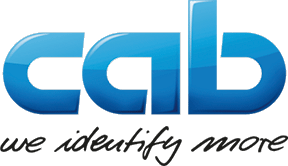Amoena Medical Technology is working with cab printers for 20 years
A visit to the world’s market leader for breast prostheses

We are visiting Raubling near Rosenheim. Here, Amoena since 1975 develops, manufactures and ships, as stated on the company‘s website, "a wide range of support for women who have had breast surgery." Essentially, these are prostheses made of silicone. These as well as most of Amoena‘s special bras and accessories demand specific requirements as regards labeling.
Mr. Walter Dinzenhofer of Amoena shows us the work stations and answers our questions. On this occasion, we also get deeper into the history of cab label printers.

- Medical-orthopaedic products demand precise marking. Pictured on the left: a cab A4+ label printer
Mr. Dinzenhofer, what has to be considered when labeling your products?
Dinzenhofer: We deliver worldwide and therefore have to meet very different requirements. The conformity of the product according to valid EC directives is indicated by the CE mark. As we are a company manufacturing medical products we are obligated to provide these goods at least with a batch number. We even go further and have serial numbers for everysingle prosthesis. This means that we have a single label printed for each prosthesis.
Sounds like effort…
Dinzenhofer: …that pays off for us. Amoena is certified according to ISO 9001, ISO 13485 and ISO 14001. Before introducing a new product there is always a comprehensive series of samples and prototypes. Only after the trial period the new products are finally released for the running production. All individual operations right through to the finished prosthesis including all parameters are notified in a lifecycle chart. This makes it possible for us to follow every step in production, quality assurance and packaging up to the shipment of the product to the customer respectively our storage facilities at the Amoena subsidiaries.
Speaking of label printing Amoena and cab have a long-standing partnership.
Dinzenhofer: This is true. We are working with cab printers since December 1994. The first devices that we had in use were of the Calypso 300 type.
How did things progress with your printers?
Dinzenhofer: The first printers were followed by the Apollo 3 and A3 models, later on the A4+, all with 300 dpi print resolution. Alle these printers did a good job over many years. If you look around here, you still can see work stations with an A3 reliably doing its work. And these printers date back to 2001! Of course the devices have to be maintained and at a high-volume printing a print head must sometimes be replaced. But all service work is done quickly and easily and after that the device is running for a long time again.
What do you expect from your printers?
Dinzenhofer: First of all we expect precise marking and that the imprints are of good quality and sustainability. A good contrast of the barcodes assures quick and easy scanning both in our house and at the customer. When using new ribbons we first print labels with different print parameters and then check the abrasion with a pull-off test. An error-free print image is the first condition. We furthermore differentiate between the applications. The product labeling must be of a higher quality than the labeling on packaging for logistic purposes.
So what is your conclusion?
Dinzenhofer: The cab printers enable us to realize everything that is needed. Thereby, we achieve very good results.
 Briefly introduced
Briefly introduced
Walter Dinzenhofer ist working at Amoena for more than 30 years. Since 2008 he is responsible for the Logistics Development at the company‘s headquarter. Label printing and barcode reading techniques are parts of his business. At Amoena there is a total of approximately 650 employees worldwide, of which 220 are in Raubling. From here, all the prostheses and a large portion of the textiles are shipped to the overseas countries by sea containers and air cargo. The Amoena subsidiaries and distributors in Europe are supplied on pallets by truck and packages directly via UPS.
© cab 04/2016


